Intel Thunderbolt 4 Update: Controllers and Tiger Lake in 2020
by Dr. Ian Cutress on July 8, 2020 9:00 AM EST- Posted in
- CPUs
- Tiger Lake
- USB4
- Thunderbolt 4
- TB4

Wired connectivity is converging onto two standards: USB4 and Thunderbolt 4. Both of these are set to debut by the end of the year in Intel’s upcoming Tiger Lake platform, and to set the scene Intel is updating us on the scope of its Thunderbolt 4 efforts.
Thunderbolt 4 is going to be a superset of TB3 and USB4, meaning that any Thunderbolt 4 Type-C host will be able to accept TB4, TB3, USB4, and USB 3/2/1 connections. Thunderbolt 4 will offer speeds up to 40 Gb/s, and there are a number of requirements for Thunderbolt 4 hosts and devices in order to be certified.
These requirements include:
- Video, support 2x 4K or 1x 8K (No detail at what refresh/bit-rate/chroma)
- Data, PCIe at 32 Gbps (storage up to 3 GB/s)
- Support for TB4 docks with four TB4 ports (one upstream, 3 downstream)
- PC Charging on at least one port (for laptops up to 100 W)
- Wake from sleep by peripherals connected to a TB4 dock
- Requires Direct Memory Access protection (more on this later)
The first devices to come to market with TB4 support will be Intel’s Tiger Lake platform, for use in laptops, which will have TB4 baked right into the silicon. TB4 will be one of the base requirements for Intel’s Project Athena certification program, and Intel is set to release a new TB4 2m cable for most use cases. Intel is also working on optical 5-50 meter cables, which will also now support the TB4 multi-port accessory architecture, enabled by 4-port TB4 hubs.
There will be two host controllers, known as Maple Ridge JHL8540 and JHL8340, for use as host controllers in desktops, workstations, and laptops. We are told the package size and power requirements are essentially in-line with previous Titan Ridge TB3 controllers. The device controller, for use in docks, monitors, storage devices and such, is the Goshen Ridge JHL8440. All three of these controllers will be available by the end of the year.
Thunderbolt 4 has no costs associated with using it, the branding, or the logo, however there is a branding/logo license. Intel has opened up the TB4 standard, but as it stands is the only company that has publically announced its intention to make host and device controllers. The cables will be branded with the Thunderbolt Logo and a number 4, however ports on systems will only have the Thunderbolt Logo, making TB3 and TB4 use indistinguishable (we disagree with Intel that users don’t check what their system uses so using the same logo makes no difference to these users – we think the same argument can be used in order to showcase the logo on devices with the number 4).
Here’s a main slide showcasing the difference between all the different standards. Ultimately TB4 is backwards compatible with TB3 and USB4/3/2/1 standards.
One of the key focal points in our briefings with Intel is that Thunderbolt 4 will have an additional requirement this time round – Direct Memory Access protection to prevent physical attacks. In our briefing (and shown on the slide below), Intel initially stated that this requires Intel VT-d technology, which raised questions about Thunderbolt 4 being limited to Intel only systems.
The spokesperson later clarified that in order to gain certification, DMA protection is required, and Intel is using VT-d to do it. Intel refused to comment on how other vendors might implement DMA protection, stating that it would be up to them. While additional security protections are always a good thing, they ideally need to be based around open vettable standards, something which might limit Thunderbolt for another generation as an Intel-only technology (whereas USB is far more ubiquitous).
We’ve reached out to AMD late in the day, and they’ll be supplying a comment soon. I will update this post when I get something.
Update, AMD says the following:
The “Zen 2” architecture supports DMA security in pre-boot and OS environments via AMD-Vi (IOMMU) on USB and PCIe interfaces.
When asked specifically if AMD-Vi meets the requirements for TB4, AMD stated:
If the question is to do we support DMA? The answer is yes. Any questions about if this would satisfy another companies requirements for an interface they are developing would need to be directed at them.
When we asked Intel to confirm if AMD-Vi met the requirements for TB4's DMA protection, we were given the following quote:
Thunderbolt is open to non-Intel-based systems. Like any other system, devices must pass Thunderbolt certification and end-to-end testing conducted by third-party labs. Thunderbolt 4 requirements include Intel VT-d based or an equivalent DMA protection technology that provides IO virtualization (often referred to as IO Memory Management Unit or IOMMU), as well as OS implementation support. If the equivalent technology supports prevention against physical attacks, then that should meet the requirement.
Overall, TB4 seems like a very capable standard, providing backwards compatibility, top class speeds, as well as new connectivity topologies. It will be interesting to see what the additional cost of adding TB4 onto various systems will be with Intel’s controllers, especially in the desktop space.



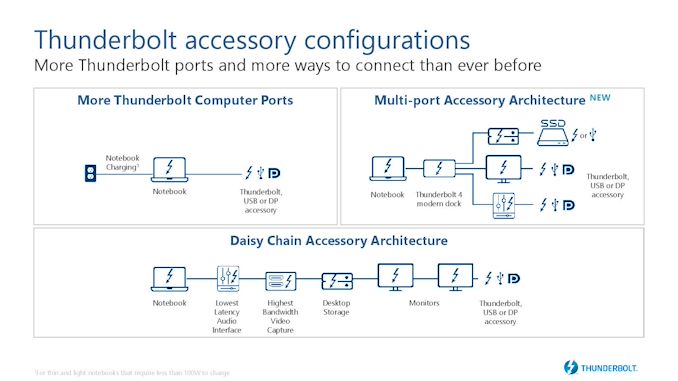
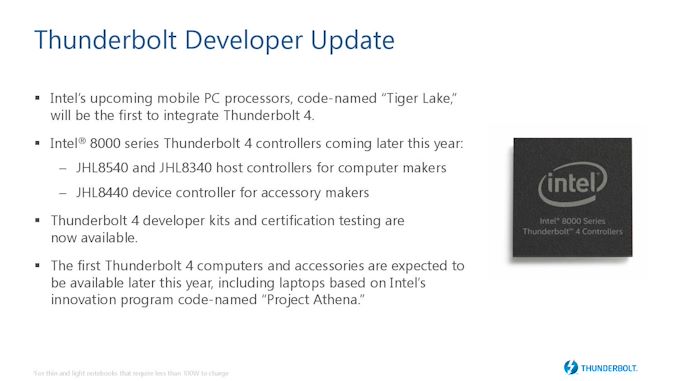

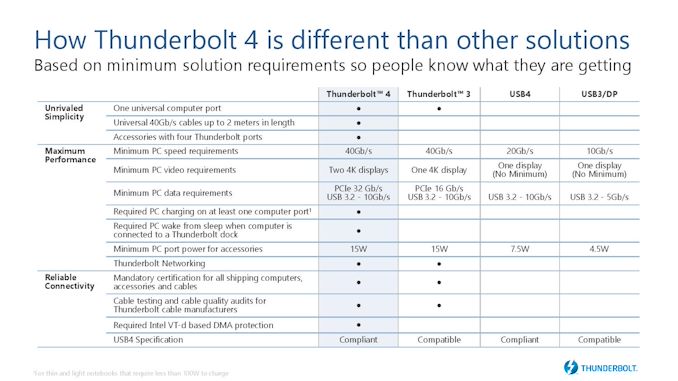
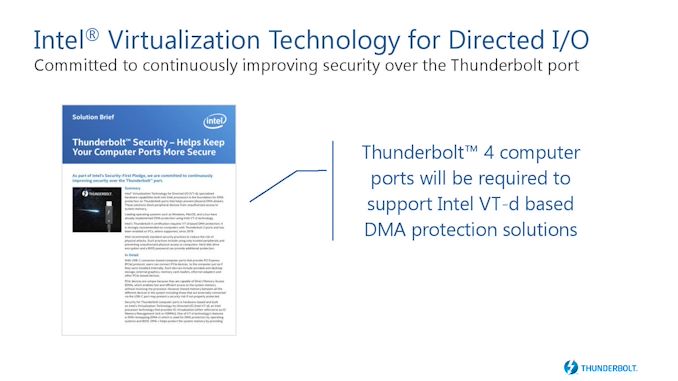
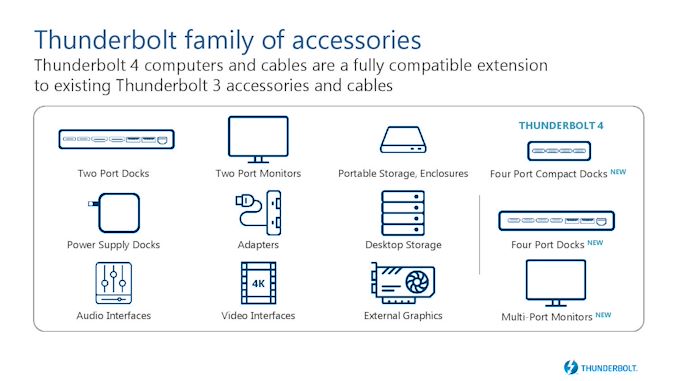














76 Comments
View All Comments
repoman27 - Wednesday, July 8, 2020 - link
No.USB4 is only conceptually based on Thunderbolt 3; it differs materially in terms of specific implementation details. Most notably, the two protocols actually use slightly different signaling rates and encoding schemes. Thunderbolt 3 interoperability is optional for USB4 hosts and devices and implemented via a Type-C Alternate Mode, same as it was under USB3. Interoperability is only required for docks and to a certain degree on hubs.
From the specification:
A USB4 host or USB4 peripheral device can optionally support interoperability with Thunderbolt 3 (TBT3) products.
A USB4 hub is required to support interoperability with Thunderbolt 3 products on all of its DFP. A USB4-Based Dock is required to support interoperability with Thunderbolt 3 products on its UFP in addition to all of its DFP.
When interoperating with a TBT3 product, Thunderbolt Alt Mode is established on the link between products. The USB Type-C Specification describes how a USB4 product negotiates and enters Thunderbolt Alt Mode.
Also from the spec:
Thunderbolt™ is a trademark of Intel Corporation. You may only use the Thunderbolt™ trademark or logo in conjunction with products designed to this specification that complete proper certification and executing a Thunderbolt™ trademark license.
Intel is still gonna Intel.
serendip - Thursday, July 9, 2020 - link
So TBT3 is a superset over USB, just like DisplayPort Alt Mode? The device is supposed to follow USB4 for full compatibility and add alternate modes if needed.Deicidium369 - Thursday, January 14, 2021 - link
TB4 spec contains both TB3 and USB4.you can have USB4 without TB3/4
Spunjji - Wednesday, July 8, 2020 - link
Is it just me or is Thunderbolt 4 looking increasingly like a rehash of Thunderbolt 3, just guaranteed to work at full speed and with some deeper vendor lock-ins?The "one port to rule them all" concept could be beautiful, but as it is, it's actually just adding to the confusion because it's impossible to differentiate from Thunderbolt 3 and will probably not be ubiquitous.
DigitalFreak - Wednesday, July 8, 2020 - link
It's TB3 with a 1m longer cable and optional stuff now required. At least USB increases it's speed with every version.chaos215bar2 - Wednesday, July 8, 2020 - link
There are plenty of 2m TB3 cables which support 40Gb/s data and 100W charging. What's different, if I'm reading correctly, is that Thunderbolt 4 cables must support full backwards compatibility. That could just be a change to the active hardware used on 2m cables.What's less clear is whether the longer optical cables will be fully compatible. Based on what's said here, I'd expect a 50m Thunderbolt 4 cable to also work as a really expensive USB 2.0 cable.
DigitalFreak - Thursday, July 9, 2020 - link
I just saw that there are 2m TB3 active cables now that can do the full 40Gbps. The last time I looked into it you could still only do a max of .5 (or 1?) meters @ 40Gbps. Those active cables are expensive af though. Don't even get me started on the fiber ones.repoman27 - Wednesday, July 8, 2020 - link
Thunderbolt 4 is USB4 with full support for the Thunderbolt 3 and DisplayPort Alternate Modes. This is significant in that Thunderbolt 3 controllers do not support USB4 at all. The two protocols are not the same.The differences between USB4 and TBT3 are discussed starting at page 68 in this slide deck: https://www.usb.org/sites/default/files/D2T1-3%20-...
Deicidium369 - Thursday, January 14, 2021 - link
Well that would be your take...Through your AMD Colored GlassesTB4 is a certification. it certifies that the implementation of TB3 and USB4 meet a certain level of functionality. No vendor lock in - Nothing stopping AMD board vendors from adding TB4 support - nothing.
A single cable - a TB4 cable - will operate at full speeds for both TB3 and USB4 over the C connector (40Gb/s)
Apple and Intel support TB - so already ubiquitous - and only a small niche player lacks it
PaulHoule - Wednesday, July 8, 2020 - link
Whoever made that "How Thunderbolt 4 is different from other solutions?" slide should make luxury car commercials.My concern is this: I have used Mac and Dell computers with Thunderbolt support and I'd say the experience is good on the mac and worse on Windows. A newer Dell I use came with a Thunderbolt dock that "just works" (charging, display, network and HID) but I have had a hard time finding pairs of machines and docks that work completely. Often everything works except the network. My Alienware (also Dell) did OK with a Thunderbolt monitor I tried, although it took much longer to configure itself than macs did.
So now I have a "four plug" docking solution at home which works with every laptop I have tried, which involved trying quite a few different devices, giving up on Logitech/Plantronics dongles for Bluetooth, ... It supplies 250W, but it does not have the one-plug simplicity that i wish for.